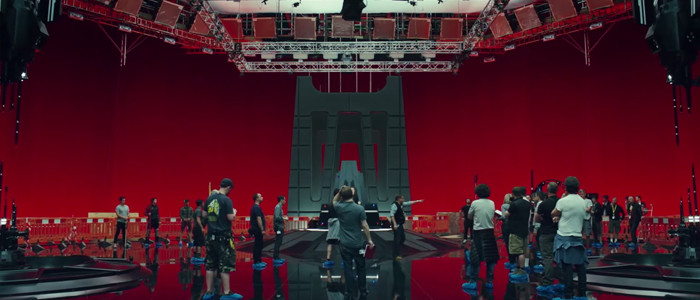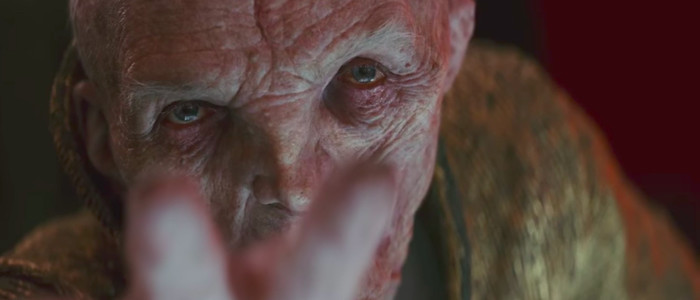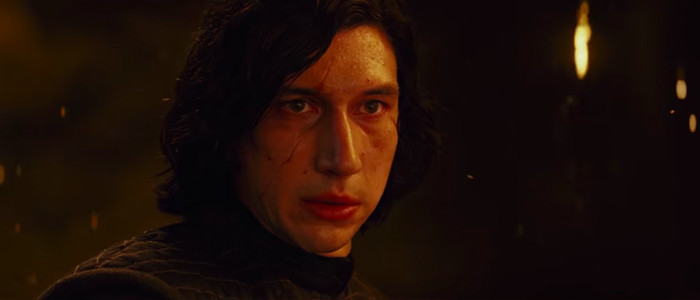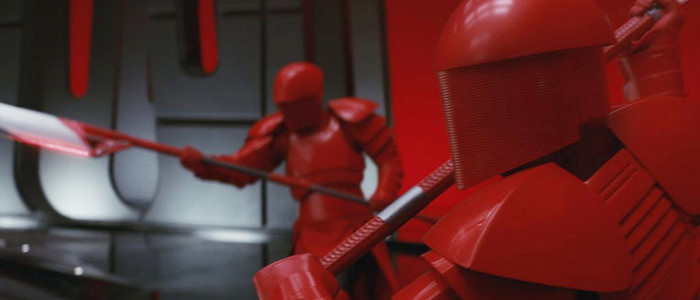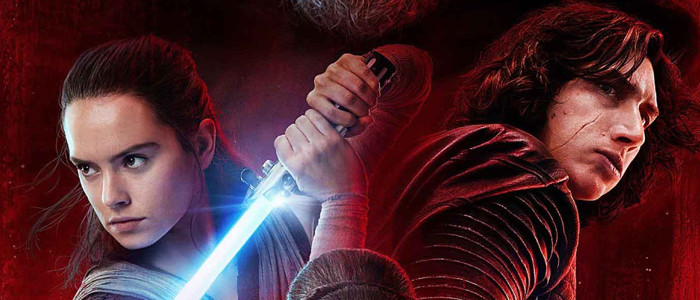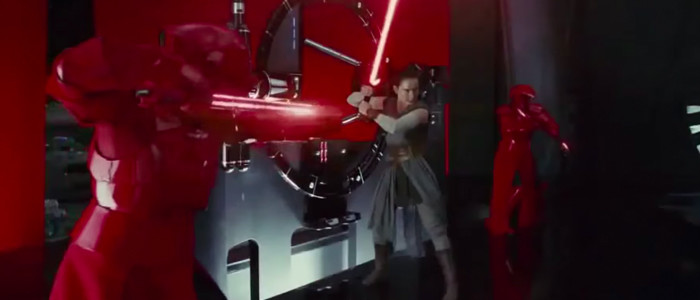'Star Wars: The Last Jedi': The Definitive Oral History Of The Lightsaber Battle In Snoke's Throne Room
(Warning: this post contains major spoilers for Star Wars: The Last Jedi.)
The latest Star Wars film is overflowing with jaw-dropping moments, but one of the most talked-about scenes is the incredible lightsaber fight inside Supreme Leader Snoke's throne room. I knew the second I walked out of the movie that I wanted to read a detailed breakdown of how that came together, so when /Film was given the chance to speak with many of the filmmakers on the movie's opening day, I decided to compile an oral history. I concentrated all of my interview time asking those involved about every aspect of that scene: the visual flair of the set design, the practical flames licking the deep red curtains, that fist-pumping slow motion moment, the death of a major character, and much more.
Here, in the words of writer/director Rian Johnson and many others, is the behind-the-scenes story of one of the Star Wars franchise's most thrilling moments.
Update 12/3/2019: Star Daisy Ridley spoke with British GQ about the making of this scene, so I've embedded that video below. Our oral history follows.
Crafting The Throne Room
Kylo Ren leads a handcuffed Rey to see his master. Doors hiss open to reveal Supreme Leader Snoke's throne room, a cavernous chamber bathed in red and encircled by armed guards. The Supreme Leader slouches lazily across a raised throne in the center of the room.
Ben Morris (Visual Effects Supervisor): That's one of my favorite scenes in the film. The throne room set was built on a stage in Pinewood, the Q stage. We always knew from conversations and preproduction meetings with Rian that these beautiful red velvet curtains that were shrouded and surrounding [Snoke's] throne would be burned away to show space beyond and the huge wing of the Mega Destroyer.
Neal Scanlan (Creature & Droid Effects Creative Supervisor): The set we were on was a stunning set. The whole red drapes that are behind that room are actually velvet drapes. The whole set was a beautifully high polished set. It was all raised up. It was a very theatrical place to be. It was almost temple-like in reality.
Rick Heinrichs (Production Designer): It was one of the earliest sequences that we discussed...we explored many different looks and feels to it, and it all came back to his desire to put across a ceremonial environment for the Supreme Leader to reign from. That was incredibly important, that the environment support the concept of Snoke at the pinnacle of – at the knife-edge, if you will – of the First Order. One of the earliest inspirations I can remember from this, I went through all the archives that I could get my hands on at Skywalker Ranch, and there was this great image that Ralph McQuarrie had painted. It was actually of Darth Vader in a throne room. And it wasn't right in terms of the practical aspect of it – it was literally like a medieval throne room with flames all around him – but the idea of creating a metaphorical hell with the use of the red color, but making it as elegant as possible, that coincides with the ethos of the First Order and the black, the reflectivity, and the hard, sharp, almost crystalline inhuman shapes that are a part of that.
Steve Yedlin (Cinematographer): We from a lighting side and then Rick from [the production design] side, we kind of got together and said, 'If we're gonna do this, let's really do it.' Figuring out that exact red, how to physically do it. And which part of it was practical and which wasn't, because in terms of the red stuff itself, a lot of it was practical. Some of it wasn't. I mean, obviously when you see space out there, that isn't practical.
Heinrichs: When you look toward the throne, you see this almost spinal and rib-like structure above Snoke. So as part of this very elegant, simple shape, there was also an incredibly important sense of power and strength in almost a metaphorically organic way as well.
Ren Klyce (Sound Supervisor): From a sound perspective, we wanted it to have a sense of foreboding. We wanted to feel a sense of being unnerved or unhinged. Dark. And so the tones that are in there, there's some heavy sort of bassy sounds and tonal steady noises that are in there that kind of create this plateau of tension. And then on top of that, the dialogue with its reverb kind of falls off into that. So you have that speaking and then the reverb goes into this tension. And then lastly the music, John Williams' score, he has this very, very demonic choir that plays through that.
Heinrichs: The most important thing for me is that we took the language of the First Order/Empire architecture, and we were able to bend it to our specific use and created something that feels both familiar and novel at the same time.
Snoke's Increased Role
After appearing as a towering hologram in J.J. Abrams' Star Wars: The Force Awakens, Rian Johnson and The Last Jedi team wanted to make Snoke a more tangible villain in this sequel. Actor Andy Serkis returned to provide the motion-capture and vocal performance for the Dark Side's most mysterious baddie.
Scanlan: We knew that Snoke was going to feature for real, rather than a hologram. We also would see him for the first time at his true scale, at his true height, and at his true physicality. We also felt, and what Rian felt, was that maybe the version in Force Awakens – time had passed a little, and some of the wounds had healed. I'm talking wounds in an almost spiritual way. His face, to try to show the torment and the twisted battle that exists within his own mind.
Morris: I'm particularly proud of Snoke. I think he's wonderful. He was always something Rian was concerned about. He came to me and said, 'The way he was played in The Force Awakens was too mysterious,' and he wanted to bring him out of the shadows, to make him utterly real. He said to me, 'Is this even achievable in CG? Do I have to go to an actor in makeup?' And I said, 'No, no, no. Absolutely not. We can go well beyond that.' So it was great taking Rian through the process as we built it, and by the end of it, he was so excited. He'd have shots he staged as a mid shot, and he'd be saying, 'Can we just push the camera in even tighter? My God, look at the stubble on his chin. Can we just go a little tighter again?' I think Rian's as happy as we are with that character.
Scanlan: We built an animatronic hand that caresses Rey's face at one point, which was physically performed by Andy [Serkis]. His relationship with Rey was one of a physical connection, and during the sequence, he was raised on a raised platform so he was at the correct height. The whole thing was motion captured by visual effects. Ben [Morris] and the guys completely covered it. He was wearing the full motion capture suit, facial capture as well.
Michael Kaplan (Costume Designer): Visually, that red environment was so beautiful, and Snoke in all of his metallic gold glory. I thought it would look loose and luxurious, and I thought it would look beautiful in that room. It does have a rough texture, which I think is much more Star Wars than if you were wearing something in fine silk. He's wearing a gold-laced dressing gown for the most part, and I think the red and the gold really work. He wasn't really there, but we did make the actual costume in reality, even though it was going to be CG. It was sitting on the throne when he got sliced in half, so that's how that was done.
Snoke's Unexpected Death
One of the film's biggest surprises is that Snoke, who fans assumed would remain the overarching villain for the entirety of this trilogy, is killed by his own disciple. After interrogating Rey, Snoke demands that Kylo Ren kill her – but the brooding pupil turns a lightsaber on his master instead.
Scanlan: I didn't ultimately find out about the death of Snoke until very much closer to the shoot date. The information gets honed or given to you as you get closer just to hold on to it so it doesn't get out there.
Morris: We always knew [his death] was going to happen. It was in the script from the word go. Snoke's obviously a fully digital character played by Andy Serkis on the day. In terms of the actual moment of his death, we have a few shots to build up to.
Scanlan: We created a full size maquette, actually a full size version of him, using all of the materials and all the things one would if you were creating a completely life-like version. But we didn't take it to any level of puppetry or animatronics – we took it to a point that it could be scanned...We kind of built toward that moment [of his death]. We built the whole puppet as an entire thing, and we then decided within about a week – or less than that, maybe a few days – where the incision was going to go, how exactly he was going to die. I think that comes from Rian talking with Andy and with [Daisy Ridley], and the whole scene is very organic. It's not completely locked down all the time. When we put in the throne, we worked it out with the guys and with Rian. 'OK, this is where he's going to get cut.'
Morris: [Snoke's] getting more and more angry, and Kylo's subtly playing the saber to turn towards him.
Bob Ducsay (Editor): Very late in the scene where we cut to the lightsaber and it starts to turn...It's a tricky thing. I mean, are you completely telling the audience what's gonna happen there? I don't know. I've seen the movie twice with an audience and they don't seem to completely get it until it happens. Just because of the way that they respond. And these are the things that when you don't put a movie in front of an audience, when you're doing it just internally, you're like, 'I think this is what they're gonna think. I hope this is what they're gonna think, because there's a lot on the line here'...but we had great confidence in that scene...It felt really good while we were doing it.
Scanlan: In fact, the [practical] model is used in the scene where you see Snoke chopped in half and you see his upper torso fall and you see his lower legs fall as well.
Morris: The practical effects guys gave us a version of a puppet that fell off the throne forward, but we augmented that heavily and rubbed out most of it. It was a great placeholder to have on set, but it just didn't match close enough with what we were achieving in the rest of the sequence, so we ended up replacing that.
Yedlin: When we did those shots, we did a bunch of versions of everything. So first we'd shoot Andy doing the performance. Because everything's gotta match that, because it's all about the performance. And then we would know what the shot is. And then we would shoot the maquette, which looked exactly like Snoke, but it doesn't move. Then we would shoot a reference of a guy in there that, I mean, I guess vaguely looks like him, but it's a person, so he doesn't actually look like him. And the VFX guys would have him move his head around so they could see him from different angles. And then we would shoot on empty to put Snoke in. The thing is, we knew we were gonna do that, so it wasn't like, 'How do I wrap my head around this?' You just know you're gonna wait and do these other versions.
Ducsay: The final Snoke thing, the cutting there is – it's pretty precise. It's very studied. That stuff changes a lot and there's a lot of time invested in that. But doesn't take away from the fact that yeah, I have all the shots I need, the basic concept of it is completely designed.
Morris: As Rey puts up her hand to pull the saber over, that searing slice that occurs is all in CG. When we cut back to when Kylo wakes up, there's a shot of Snoke's face that's splattered on the floor. Originally that was going to be a piece of prosthetic animatronic, but ultimately during the course of post-production, we redesigned Snoke, and so that no longer matched what he looked like. So we actually had to replace that with CG as well.
Scanlan: The way a lot of these things often happen is that when you see an actor's performance, when you see Andy's performance and you hear Andy's voice, you close your eyes and you imagine something. It isn't always going to be that the decisions that you made nine months or eight months in advance are always going to be right...That's the joy of filmmaking. It isn't just a pre-defined process. That's one of the joys of digital. At a certain time, you can almost go back and add a tweak or a slight change, and I think it was generally felt that the Snoke that we had was probably, shall we say, not as powerful or as commanding as Andy's performance was. I'm sure that was one of the motivating reasons to say, 'Why don't we just do some little changes here?' just to make the two really marry together. I think maybe [the initial Snoke design was] a little vulnerable, and maybe a little weak, both from a facial aspect and maybe even from an animation aspect. Once you see Andy walk and you see Andy hold himself, Snoke's actual skeleton or anatomical makeup might have been slightly out of ease with that. So digitally, you can tweak that slightly and move things. I think you can get away with a lot of things within the cut or within a camera angle, but there are certain sections where you look and go, 'No, we're too vulnerable here. We have to make those changes.'
Kaplan: When we see Snoke get sliced in half, his arm and his hand remain on the throne, and he's still wearing his ring. I thought it was pretty amazing to see, after he's sliced in half, to still see his hand still grasping the arm of the throne, wearing the ring, when he was no longer sitting there. There's a wonderful creepiness.
Rian Johnson (Writer/Director): The first thing to say is coming into writing this or any story, the object is not to subvert expectation. The object is not surprise. I think that would lead to some contrived places. The object is drama. And in this case, the object was figuring out a path for each one of these characters where we challenge them and thus learn more about each of them by the end of the movie. So that having been said, Kylo's arc in this movie I saw as – besides his relationship with Rey – the big arc for Kylo in this movie was breaking down this kind of unstable foundation that he's on and then building him to where by the end of the film he's no longer just a Vader wannabe, but he's stepped into his own as kind of a quote unquote villain, but a complicated villain that you understand, right? So with that in mind, the idea that Kylo would get to that place by the end of it led me to think, 'Well then, what is Snoke's place at the end?' And does that work with him just kneeling before Snoke at the end? No. If Kylo's gotta get to a place of actual power, the ultimate expression of that would be him ascending beyond his master. And that also then gives the opportunity to have a great, dramatic moment that you don't expect of getting Snoke kind of out of the way. So that really is where it all stemmed from. It was thinking about Kylo's path, thinking about where I wanted him to be at the end of the movie to set him up for the next film. And thinking, 'OK, that means we're gonna clear away this slightly more familiar dynamic of the Emperor and the pupil.' Clear the boards from that, and then that's much more exciting going into IX, the notion of now we just have Kylo as the one that they have to deal with.
The Praetorian Guard
Following the Star Wars tradition of the Emperor's Royal Guard (first seen in Return of the Jedi) and inspired by ancient Roman fighters who served as their emperor's personal security detail, Johnson wanted Snoke to be protected by an elite fighting unit of his own in The Last Jedi. These red-clad defenders are known – as they were in the Roman era – as the Praetorian guard.
Kaplan: I had an idea and I just kind of went with it. I shared it with Rian after the fact and he loved the designs. What I did was, I kept thinking of bright red muscle cars from the '70s – the vents and the reflection of the shine. So I did a mood board of different elements and started working with my concept artists and created these costumes that were somewhat samurai warrior, which I think is something that fit very well into the Star Wars vernacular, and also the '70s muscle cars being when the initial films were made back in the '70s. I love grounding the film at the time when George Lucas made the original film with haircuts and things like that, because it keeps us in the same world. All the rebels' haircuts and Kylo Ren's longer hair, I don't want it to look like today's times. I want it to look like Star Wars, which was built upon the way people looked back then. That was something I thought was important to stay with. The Praetorian guards don't have faces. They don't have eyes. But they needed to see. So what we did was these tiny, tiny little saw lines, like stripes, in the face. They can see enough through that latticework. It's pretty amazing that they had full visibility so that nobody got hurt.
Morris: Even all the big weapons that the Praetorian guard had as well, they all needed tracking in, and they all had their own separate characteristics. The whip, when Rey gets pulled toward the guard, that wasn't even there. [The stunt performer] was just play acting. [laughs] He rehearsed it endlessly with a practical whip, but we asked him whether it was possible to do it without, and he did an amazing job with Daisy on the day when we had to track in a CG whip that was tethered to her lightsaber.
Klyce: We really were inspired by the original Ben Burtt sounds for the lightsaber, naturally. And we ended up recreating some of the sounds of the lightsaber using exactly the original sources that Ben used. And then swinging the microphone in front of the speaker the way he did, but reimagining it, as we called it. For the Praetorian guards, Rian wanted the sounds – the weapons are very different. Some snap apart. There are these sort of katana blades. Or one of the guards will hold this blade, but on top there's a very sharp line of laser that scintillates. And so I started just creating steady textures, kind of in the same school of Ben creating the steady textures for the lightsaber...The sparks, when they hit each other and also when Phasma's fighting Finn, we went into the scoring stage at Skywalker. There's this big room which normally records orchestras, and it's got this fantastic acoustical signature where you clap your hands and it goes [MAKES NOISES]. And it has this beautiful sound in there. Jon Borland, our sound editor, had this great idea to take – it's goofy – to take a plastic bag for packing and pop it. And it goes [MAKES NOISES]. But we record at 192 kilohertz with these high bandwidth microphones. Take that sound, then you slow it down so it'll go [MAKES NOISES], and it creates a much lower pitch. But the fidelity of that sound, because you're sampling at such a high sample rate, the fidelity's still very good quality. And then those sounds added and manipulated with other sparks created the clashes for those weapons. So yeah, a lot of little new sounds for the Praetorian guards in there. Blades. [Skywalker Sound re-recording assistant] Tony Sereno's kids found this knife. It's like a letter opener on a sheath and it just, it was just this weird, random knife. So [MAKES NOISES] pulling it out and just rubbing this thing. It had these edges, so we just recorded that. And so whenever they're swinging it, it's that sound of the little knife. So lots of little, tiny sounds kind of stacked for those guards.
Kylo and Rey Join "Forces" in Slow Motion
After killing Snoke, Kylo Ren uses the Force to retrieve the lightsaber that sliced his master in two. Rey grabs it out of the air, stands up, John Williams' score swells, and the film slides into slow motion as the two of them stand back to back and unite to face off against the Praetorian guards.
Morris: [Rian] wanted it to be an epic moment. The audience suddenly thinks that there's a pairing that's occurred, and so there's this huge, triumphant, euphoric, 'Yes, this is it!' [reaction]. But it's ultimately false. He wanted an epic spectacle. He wanted to rip up the throne room.
Yedlin: When we shot that, we did so much work, obviously, in planning how to light it, everything. But even on set when it was happening, I was just as amazed at watching it as a fan, because I hadn't seen all the choreography. I knew what it was like as a description, but I hadn't been there in all the sessions with Rian with the fight guys and stuff. So when we're setting up that shot and it's like, 'OK, let's do a rehearsal,' and you get all the stunt people there and Rian's got that wide lens on the finder and we're just like, 'Oh my God, this is just amazing.' I would be shocked if Rian had planned precisely about the slow motion thing. I mean, he does plan a lot. We pretty much know what all the shots are. I mean, there's a few exceptions like a late-written dialogue-only scene or something like that. But like really fine detail? Not necessarily. Something that Rian is really good at and that I strive to be good at – I don't know if I'm good at it, but it's something I try to do – is not doing false precision. Because I think sometimes what happens is people, I've seen it happen where in prep, people will get way too fine grain. Like they wanna know what focal length they're gonna shoot something on the 50th day of shooting...It would be like an author saying, 'OK, I know that on the 200th paragraph, I wanna have seven consonants in the first sentence' or something. You're like, 'What? Who?' That's too fine grain. You're gonna do that when you write the sentence. You're just writing an outline right now. And I think something like [the slow motion shot] would, I don't remember on that particular one, but that feels like a more fine grain decision than a planned one.
"Reylo" vs. The Praetorian Guard
The slow motion subsides and a huge fight commences. Rey hurtles one of her opponents' weapons into the red drapes, and they catch fire. The flames spread as the battle rages on, and eventually the curtains burn away completely, giving way to falling embers that rain down during the emotional reveal of Rey's true parentage.
Heinrichs: One of the things we had to come to terms with was finding out that there were several different layers of things we had to consider. Apart from our set, there was a lighting layer – and when I say 'layer,' it's literally several different physical beams that are raised an lowered on mechanical, electrical chain motors that can come down as you reposition and go back up. There was all the stunt coordinator's equipment, which is a second layer we had to plan for, which suspended Rey in the air. All these different pick points had to be found, and oftentimes they would slice through set elements that we would have to detach and remove and then put back in. Then there's just a layer of special effects that happen and all of their specific needs, with the fire and all of the safety and health issues that arise from that. We're front and center with all that stuff because we're building the physical environment for the company, so all of those layers and having to deal with those are the real issues we deal with as we're trying to get things prepared and maintained throughout the shoot.
Morris: We talked long and hard with Chris Corbould and the practical guys about what you can do safely on a set in terms of fire. It turns out you can bring fire onto a stage, but it's reasonably limited.
Chris Corbould (Special Effects Supervisor): My main involvement was really the fire effects of it and dropping lots and lots of flaming debris around them when they fought – which sounds easy, but it's not. [laughs] You have to hang it all up and not cue it up too early because it burns through and drops too early, so that was quite intricate and we spent a lot of time testing it. It's something that has to be very carefully coordinated and rehearsed. You have to spend several weeks testing various materials to drop down. A lot of it was CG, obviously the background stuff was CG, but the flames falling amongst them as they were fighting was all practical fire...Rian's cue to me was just like, 'We know they're having the fight. Let's make it as interesting as we can.'
Morris: Beyond that, the atmospherics and all of the background effects and the saber interactions were entirely done digitally. It's just a beautiful piece of very complex saber work. The great thing about sabers in this environment is every time they touch the floor, they come through this burning gouge, and we had to work out how to simulate that. In order to do that, we had to perfectly track all of the practical sabers with LED lights, so we had interactive lights on the film set.
Corbould: Rian is a very practical-minded person. A little bit like Chris Nolan. Anything that we would do practical, he would take. So it was up to me to explore the avenues of what we could achieve. It's something I'm very passionate about, to get as much on screen realistically as I can. Sometimes we use a little bit of enhancement from the visual effects guys, that helps, but I'm a firm believer that if you get something based in reality, it looks a lot better. The actors have something a lot better to react to and work with, so Rian and I were like minds on that. He tried to get us to do as much as we possibly could practically.
Morris: The other thing about Snoke's throne room, in the early stages of the fight, the floor reflected the wrong image. So not only were we replacing the burning walls, the red curtains, but we also had to replace the reflections on the floor. So it was an incredibly detailed piece of roto-tracking and effects simulation and mostly normally composited.
Yedlin: I think [Rian] was really finding the absolute, perfect shot in the moment. And I think the best example of that is the fight scene where just as a – not even working on the movie, just as a filmgoer – I love how that's, to me, such an exciting fight scene and such an exciting way to show it...It was kind of the same as when he's just setting up a shot to do a push-in on an actor in a dialogue scene, in that he'd already worked out all the stuff with the fight choreography guys so the fight would be – we're not figuring out what the fight is. And he would just hold the director's finder and [find] that here's the absolute best way to shot it. On the one hand, it's not that kind of 'shaky bunch of camera, long lens, we'll cut it together later.' It's so designed and confident. But on the other hand, it's in there and dynamic and he would just hold that finder and he would be going all over the place, and then we'd be setting it up for a long time...and light it to be amazing.
Morris: It's just a remarkable piece of filmmaking and action, and I think it started off with the stunts, but the visuals and the sounds are what made it in the end.
Morris: The actual brunt of the work as the fight progresses was mainly visual effects, and I think everyone was just blown away at the first couple of versions of a couple of the shots that we did. People just couldn't believe it. Even the sound guys were like, 'Oh my God, this is going to be the most spectacular thing!' [laughs] So it just got better and better. The action within the sequence stayed pretty much the same, and the degree to which we revealed the exterior, we could just time it perfectly with Rian and decide which shots told which part of the story.
Heinrichs: I think that as we discussed what happens in the set over the course of it, the initial strong red color and how red evolves over the course of the scene has everything to do with the action that happens within it. So yes, we had an incredibly striking visual color that seems to override the entire scene that, as things progress and the fighting ensues and that burns down, it reveals the black void beyond. It underlines the ceremonial face that Snoke is putting on for anyone who happens to come before him.
Morris: The guy who gets thrown down the pike and comes up, that's all digital. He comes out, and Rian wanted it to be sort of like a garbage bubbler, spewing out all of the red husks of the character, the red guard. We managed to take somebody's head off, which I didn't know that we'd be able to do. There's obviously the cute bit – well, not the cute bit, but the fun bit – where Kylo catches the saber and blows out the guy's eyeball. All of that sort of stuff we knew about on the day.
Ducsay: We went back and forth a couple of times about putting parts of [the fight scene] together [in the edit] or not, but that was the only thing. We ended up I think at the same structure that it was originally written. Very, very little in the sequences were cut. And in fact those were sequences that came together very, very quickly and are very, very close to how they were at the start, how they were first put together.
Morris: One of the other residual benefits of that epic fight is there's that wonderful confrontation between Rey and Kylo, where [Rian] spoke a lot about how he wanted this beautiful falling rain of embers and sparkles, and this beautiful texture and feel behind that whole conversation and moment they have together. That was achieved entirely in visual effects, and I think it's very successful. It plays very well in that poignant moment between the two of them before they tear the saber in half.
Ducsay: Rian is terrific visually and the camera's always in the right place and it's always there to tell a story. This is the thing about making movies is story, story, story. Character, character, character, right? And the camera does that too. And where does the camera need to be to inform the audience at exactly the right time? If we're behind Kylo and he does this, the camera's finding him at just the right time. It really is what makes a sequence like that work so well. And of course these great characters.
Morris: I think it's a wonderful piece of saber fighting. It's the best piece of saber fighting, in my opinion, in the Star Wars films.
Ducsay: [That scene is] certainly one of my favorite things in the movie. It's really fantastic, right? I mean, the movie's really – the screws are tightening. It's taking off, isn't it? It's really quite something. And I just love what happens in the scene. Because where we get to with Kylo and Rey, you believe. And then the turns that happen, you believe. It's amazing. And just as a viewer, I'm so excited to see that. If I didn't have anything to do with this movie, I'd just be going bonkers over that.

